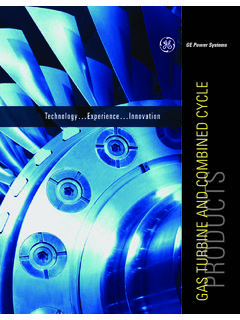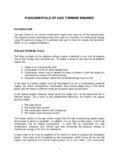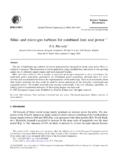Transcription of Power Plant Electrical Distribution Systems
1 PDH Course E184 Power Plant Electrical Distribution Systems Gary W Castleberry, PE 2008 PDH Center 2410 Dakota Lakes Drive Herndon, VA 20171-2995 Phone: 703-478-6833 Fax: 703-481-9535 An Approved Continuing Education Provider PDH Course E184 Power Plant Electrical Distribution Systems Gary W Castleberry, PE Course Description This one hour course provides an introduction to the design of Electrical Distribution Systems found in Electrical Power generation plants. The type of equipment utilized in the Electrical Distribution Systems is discussed in terms of its design, function, role and backup capabilities. A short quiz follows the end of the course material.
2 Learning Objectives Upon completion of this course one should be able to understand the role of the following equipment in a Power Plant Distribution system: Main Electrical generator, isolated phase bus duct, step-up transformer, station auxiliary transformer, non-segregated phase bus duct, station startup transformer, medium voltage switchgear, secondary unit substations, and motor control centers. Along with the role of each type of equipment, one should understand how the equipment is utilized to provide reliable Power to the station. Introduction Modern Power plants have an extensive Electrical Distribution system to provide reliable Power to all of the support equipment in the Power Plant . The utility operating the Power Plant is in the business of generating Electrical Power twenty four hours a day, seven days a week.
3 Since Electrical Power can not be economically stored the plants must be online to produce Power when the Electrical demand is present. In this regard, the Power plants must be highly reliable. Backup Power sources within the Plant must be ready to supply needed Power within moments. This course will provide an overview of these Systems and the relationships between the different Systems . Course Content Gary W. Castleberry Page 2 of 16 Large Electrical generation Power plants ( Power stations) today come in all varieties. Some of the plants utilize fossil fuels such as coal, oil and natural gas to fire boilers as tall as a twenty five story building. The boilers produce the massive amounts of steam necessary to spin large turbines connected to Electrical generators.
4 Nuclear plants produce the same large amounts of steam but use a nuclear reactor as the source of heat. Regardless of the type of Plant , PDH Course E184 the stations auxiliary components require substantial Electrical Distribution Systems to provide reliable Power . In the fossil Plant these components include large circulating water pumps that provide cooling water to the turbine condenser, large fans that move the combustion air through the boiler and feedwater pumps that circulate the water through the boiler. Nuclear plants have similar circulating water pumps and feedwater pumps. In addition, the nuclear plants have emergency equipment that supports safe operation of the reactor.
5 Both nuclear and fossil plants have large battery banks that provide backup DC Power to the Plant controls. These batteries are kept charged by large battery chargers. The designs of the Electrical Distribution Systems are quite similar from Plant to Plant . Even the nuclear plants Systems are somewhat similar although they have much more redundancy built into the designs. The reason the Plant designs are generally the same is because utilities have perfected these Plant design over the last century and continue to use what is a proven approach. When the nuclear plants came along in the 1960s and 70s, the existing proven Electrical designs were simply modified slightly and used in the nuclear Plant designs. The following one-line diagram shows a typical Power Plant Electrical Distribution system.
6 Gary W. Castleberry Page 3 of 16 PDH Course E184 The one-line diagram shows a simplified arrangement of the primary Electrical components. A more detailed discussion of each component follows this narrative. Starting at the upper left corner of the diagram, a circle symbol with a Y in the center represents the Plant main Electrical generator. The output of the generator is connected to the isolated phase bus duct shown as a green line. The isolated phase bus duct connects the output of the main generator to two other components: the step-up transformer and the station auxiliary transformer. The Step-up Transformer increases the generator voltage from 22,000 Volts or 22KV (Kilo-volts) to the transmission voltage of 500KV in this example.
7 The transmission voltage varies from utility to utility and from Plant to Plant and is really a function of the transmission design that already exists ( if a Plant is built near an existing transmission line of a certain voltage, typically that will be the voltage chosen for the step-up transformer). Gary W. Castleberry Page 4 of 16 The Unit Auxiliary Transformer is the Power transformer that provides Power to the station s auxiliaries during normal operation. This transformer is connected directly to the Main Generator and as such will provide the cheapest Power for the station use since any Power from the transmission lines has losses associated with it due to the line losses and transformer losses from whatever step-up transformer provided that Power .
8 This Unit Auxiliary Transformer (UAT) is a three winding transformer having one primary winding rated 22KV and two PDH Course E184 secondary windings rated and This allows the transformer to Power two different voltage level buses in the Plant . The UAT s secondary windings are connected to the Non-segregated Phase Bus Duct or (Non-seg Bus). This bus work conveys the Power to the different medium voltage switchgears located in the Plant . In this Plant design there are two sets of switchgear buses rated at and 4160V. Each bus (shown in black) can be energized from the Unit Auxiliary Transformer. The same is true for the 4160V switchgear. There is another transformer shown in the drawing.
9 The Start-up Transformer is energized from an incoming transmission line rated at 230KV. This transformer is also a three winding transformer and can feed all four of the switchgear lineups. This transformer is used to Power the Plant equipment while starting the unit up from cold conditions ( no fire in the boiler). All plants utilize a numbering scheme for their switchgear and circuit breakers. The scheme utilized here is as follows: The first digit of the number refers to the voltage level of the bus. A 1 is for , a 2 is for 4160V, and a 3 is for 480V. The second character of the numbering scheme is a letter, either A or B and stands for which bus you are connected to, of the two buses at that voltage. A breaker with the characters 2B would be on the B bus of the 4160V switchgear.
10 The next character in the designator is simply the breaker number. Notice that similar functioning breakers are usually assigned the same breaker numbers. Breaker 1A-1 and 1B-1 are both the incoming supply breakers from the Unit Aux Transformer and Breakers 1A-2 and 1B-2 are the incoming supply breakers from the Startup Transformer. The remainder of the one-line diagram reflects the low voltage system which is operated at 480V. This system is supplied by breakers from the 4160V bus and the voltage is stepped down to 480V by the 4160V/480V transformers shown on the drawing as SUS Transformer (Secondary Unit Substation). The Electrical Distribution system shown on the one-line diagram is typical for most plants for the configuration as shown.


















